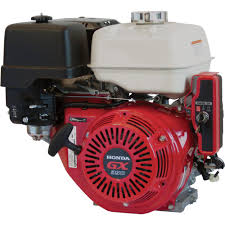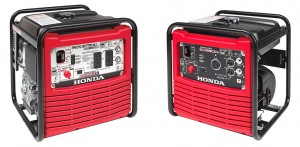 The high temperatures and low rainfall of midsummer are hard on your lawn, which makes it important to do what you can during this stressful period and before winter hibernation. While you may need to rent some specialty devices, the Honda equipment you already own can aid and sometimes replace these devices when preparing your lawn for fall.
The high temperatures and low rainfall of midsummer are hard on your lawn, which makes it important to do what you can during this stressful period and before winter hibernation. While you may need to rent some specialty devices, the Honda equipment you already own can aid and sometimes replace these devices when preparing your lawn for fall.
Aeration
Foot traffic and construction can compact the soil over time, which can keep oxygen and water from reaching the root system. A coring aerator gets the best results since it removes compacted soil instead of pushing it to break it up. The cores left behind can be chopped up by your mower, but this is hard on the blade, so it will need to be sharpened before you next mow.
Dethatching
If the thatch layer, the dead material on the surface of the soil, is over a half inch thick, it should be removed using a dethatching rake or power dethatcher. This loosened thatch can then be mowed and bagged for disposal. Mulching the grass can reduce thatch buildup by keeping the microorganisms in the top layer of the soil well fed so they be able to tackle woodier plant material.
Fertilizing
Fertilizing starts with your mower: mulching breaks down the grass into small pieces that are easy for microorganisms to digest, returning nutrients to the soil. By using a mower with Honda’s Twin Blade system, you can even mulch when the grass is wet for maximum nutrient recovery.
There are plenty of specially blended fall fertilizers on the market, but before you start the application, you need to have the soil tested to make sure you’re feeding your lawn what it needs. After application, the lawn can be mowed after granular fertilizers have been applied after watering, while liquid fertilizers should be allowed to dry for 24 hours.
Applying Herbicides and Insecticides
In the late summer and early fall, broadleaf plants like dandelions are preparing for winter by transferring carbohydrates to their roots. By applying herbicides during this period, these poisons will be drawn into the roots, killing the entire plant. Have a grub problem? Now is the time to apply an insecticide to stop their growth.
Seeding
Once the soil preparation is finished, it’s time to overseed any bald spots so they can take root and get ready for the winter. Mowing the grass at your mower’s lowest height and bagging the clippings will help the seeds get maximum contact with the soil, and it will help the new grass grow along with the old, evening out your lawn.
Pruning and Trimming
Late summer is the perfect time to trim shrubs and bushes, and with Honda’s VersAttach pruner and hedge trimmer, you can have all the tools you need to get the job done quickly.
If you’re dealing with an old or overgrown shrub, cutting back a third of the oldest, thickest branches will encourage the growth of new stems from the root of the plant. Once the shrub is at the right height, cut the top off after it’s had a chance to grow another 6-8 inches. Shaping the plant so that the base is wider than the bottom will increase sunlight exposure.
Mowing
Tall grass helps retain moisture at the peak of summer temperatures, but it’s also a good idea to keep the turf layer thick into early fall to push out weeds, make it harder for grubs to hatch and more easily identify areas that need to be seeded. Most grass varieties should be kept at a height of two to three inches for optimum coverage. Unless you’re overseeding, never remove more than 1/3 of the grass at one time: this helps the grass recover faster. After mowing, check the grass for tearing at the tips, which indicates a dull mower blade.
Edging
Using your string trimmer or brush cutter, you can create narrow trenches around landscaping features and between the lawn and paved areas. The resulting borders help features stand out, and they can halt the ingress of plant roots into your sidewalks and driveway. Doing this in the fall will help these borders survive the winter, making it easy to re-establish gardens and thick mulched areas underneath trees next spring.
Keep Your Equipment Ready with Parts from Honda Lawn Parts
Hondalawnparts.com is a certified Honda Power Equipment and Small Engines dealer, so we carry everything you need to keep your lawn care equipment working. Our site has built-in parts diagrams to make it easy to find what you need, and we can ship those parts anywhere in the U.S. and Canada.



